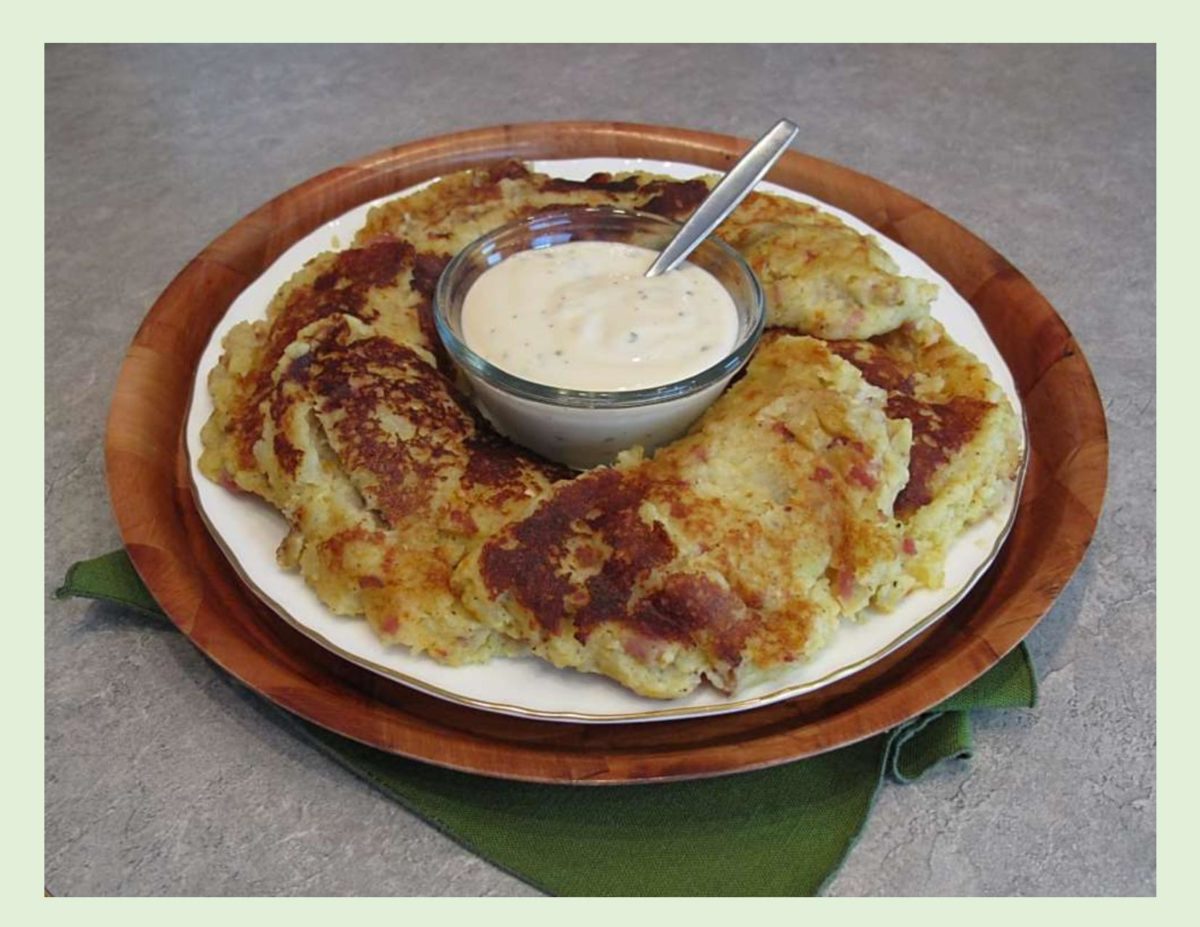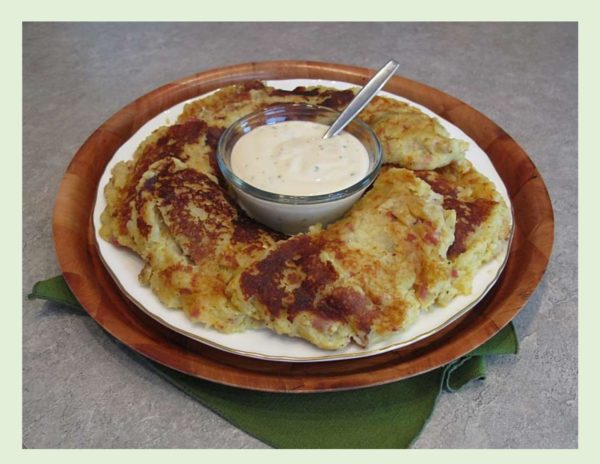
Pastetli were invented in the early 1800s in Antonin Carême’s pastry store in Paris, France where they’re called vol-au-vent, French for ‘windblown’ to describe its lightness. While they’re served as an appetizer in France, they’re eaten as a main meal not only in Switzerland but also in Belgium and the Netherlands. It is also from the Netherlands where the Swiss name Pastetli origins from. The Dutch call them pasteitje (little pastry). From there it came to the German Pastete. Just to add a little complication though, a Pastete in Switzerland is rectangle cake shaped puff pastry pie filled with sausage meat, mushrooms in a creamy sauce.
A vol-au-vent is a light puff pastry shell that resembles a bowl with a lid. The shell is generally filled with a creamy sauce (most often a velouté sauce) containing vegetables, chicken, meat or fish. The lid is placed on the filled shell and the pastry is then served as an appetizer, also known as bouchée à la Reine, or as the main course of a meal. When prepared, the pastry dough is flattened and cut into two circles. A smaller circle is cut out of the center of one of the circles, which then will be used as the lid. The circle without the center cut and the circle with the center cut are then joined together around the edges so as the pastry bakes, it rises into a shell with a hole in the top. The lid, which is baked separately, is added later. The pastry shell may be made the size of an individual serving, or it can be made in several different sizes to become a main serving for one or a larger size to be served for more than one.
Vol-au-vents rose to prominence in Paris in the 19th century. In post-war Britain, they were a mainstay of any self-respecting buffet, served to suitably impressed guests alongside welcome drinks at dinner parties. By the 1990s, they had become unfashionable and remained so for decades. Updated vol-au-vents started reappearing in chic restaurants a year or two before the covid pandemic (2020) erupted and have become the retro appetizer or main course to have.
You can even adapt them to make some elegant desserts. Fill with cream and fresh fruit or melt a chocolate orange with a dash of Grand Marnier and orange zest then spoon this quick-fix mousse into the cases and top with sweetened Chantilly cream and chocolate shavings.
For our main course vol-au-vents, I am making an interesting filling which includes, chicken, shrimp, mushrooms and tiny meatballs. Sounds a little odd but is packed with flavor.
Print Recipe
Chicken, Veal & Shrimp Pastetli (Vol-Au-Vent)
Votes: 1
Rating: 5
You:
Rate this recipe!
|
|
Votes: 1
Rating: 5
You:
Rate this recipe!
|
Instructions
Chicken/Broth
Add the rosemary, garlic, bay leaves, cloves, chopped celery, carrot and onion to a stock pot. Season generously with pepper and salt. Cut the chicken up: legs, wings and breasts. Also chop up the remaining carcass. Add it all to the pot. Then fill it with water (about 7 cups) until the chicken is fully submerged.
Place the pot over high heat until boiling, then leave it there for 10 minutes. Turn the heat lower and gently cook the chicken for about 30 minutes. Remove the chicken from the heat and let it cool down for another 45 minutes.
Mushrooms/ Shrimp/ Cheese
Chop the mushrooms into bite-size pieces. Peel & devein shrimp. Grate parmesan cheese.
Puff Pastry Shells
-
Cut (4) 5-inch circles from puff pastry. Beat the egg & prick holes in the large circles with a fork & brush with egg. Cut 12 more RINGS from pastry about an inch wide. Lay a ring on each of the 4 circles & brush with egg wash. Repeat this until there are 3 rings on each large circle. Bake the puff pastry shells for 25 minutes.
Finish the Broth
Remove the cooked chicken from the hot stock. Reserve stock for later. Remove any chicken skin, bones, veins, cartilage, or sinew (discard all this) & pick the cooked meat from the bones. Shred the larger bits up roughly. Then transfer the chicken meat to a large saucepan.
Strain the chicken stock in a fine sieve or colander over a large pan. You should end up with about 6 cups (1,4 l) of chicken stock. Discard the cooked vegetables.
Meatballs
In a bowl, combine ground veal (pork), salt & pepper, egg & breadcrumbs. Mix well and make tiny balls of ½ oz (15 g) each. You should end up with about 20 of them. Cover the meatballs with cling film and store them in the fridge until later.
Bring the stock to a gentle boil again. Once warm, add the meatballs, shrimp & mushrooms.
Poach them for about 5 minutes. Then remove the meatballs, shrimp & mushrooms using a slotted spoon. Add them to the shredded chicken in the large saucepan.
Béchamel Sauce
Take the chicken stock off the heat now. In a large saucepan melt the butter over medium heat. Add the flour and whisk well until you get a wet crumble. Gently cook this over medium-low heat for about a minute. Then gradually add splashes of the warm chicken stock until you get a sticky flour paste. Keep stirring. Don't add too much at once or the sauce will become lumpy.
Whisk well. Gradually add more chicken stock (about 3 to 4 cups) until you get a pretty runny sauce. Bring the sauce to a low simmer & cook for 3-4 minutes or until thickened. whisk in Montreal Steak Spice, onion salt, garlic powder, mustard & grated parmesan.
Add the béchamel sauce to the chicken, meatballs, shrimp & mushrooms. Stir carefully. Cover the pan for another 5 minutes and let the vol au vent filling warm through or place it back over very low heat.
Put the vol au vent puff pastry casings onto 4 serving plates. Top with the chicken, meatball, shrimp & mushroom filling. Garnish with chopped fresh parsley if desired. Serve the vol au vents hot.

Just for a change of pace, I decided to make a nutty tasting bulgur wheat stuffing instead of the traditional bread version for our tenderloin today.
Bulgur is more than just something to make tabbouleh with. Its nutty taste and hearty texture work in so many dishes or you can just use it as a substitute for other grains like brown rice, couscous or quinoa.
This kind of wheat should not be confused with its less-tricky-to-harvest cousin, cracked wheat. While they are similar, cracked wheat is completely raw while bulgur is pre-cooked and has a much shorter prep time.
For me, if the recipe involves grain, I’m in! I guess you can take the farmer’s daughter off the farm but you can never take away her love for food with grain in it.
Print Recipe
Pork Tenderloin w/ Bulgur Apricot Stuffing
Votes: 1
Rating: 5
You:
Rate this recipe!
|
|
Votes: 1
Rating: 5
You:
Rate this recipe!
|
Instructions
In a saucepan, place bulgur & vegetable broth. Bring to a simmer over medium high heat. Cover, reduce heat to medium low & simmer until tender, about 10-12 minutes. Add chopped apricots during the last 5 minutes. Remove from heat & drain any excess liquid. Set aside.
In a large bowl, whisk together egg & spices. Add almonds, scallions & reserved bulgur & apricots; mix to combine.
-
Butterfly pork tenderloin & pound with a meat mallet to an even thickness. Place on an oiled piece of foil paper on a baking sheet. Cover one half of the tenderloin with stuffing; press to flatten a bit. Fold other half of tenderloin over top stuffing. Secure with kitchen twine to keep stuffing from falling out during roasting.
Brush with olive oil & season with salt & pepper. Roast about 45 minutes or until tenderloin has a slight pink color remaining. Remove from oven & allow to sit for a few minutes before untying & slicing.
For the blog picture, I opened our whole tenderloin before slicing to show how nice this filling is. These flavors are so good!

Potato pancake variations are present in National cuisines all over the world and considered by many to be pure comfort food. The nice thing is, you can create this great meal by using leftover mashed potatoes. It can be kept simple or you can amp up the flavor with cheese, onion, bacon or a variety of spices. I recall my mother making them. I think she just added some eggs, onion, a bit of flour and some salt & pepper to the leftover, mashed potatoes. They were made into patties and pan fried as you would a pancake.
Depending on which part of Eastern Europe you come from, the name varies — Kolduny, Zrazy, Kartoffelpuffer are just a few. Regardless of the name you call them, they are just simply delicious. The Russian version takes it a bit further. The potato pancake is stuffed with a filling and then fried to a golden brown.
After reading through numerous recipes, I decided to ‘meld’ some of them into my own creation. These are what developed — nothing pretty but really good flavor. Yes, truly comfort food.
Print Recipe
Potato Pancakes w/ Pork Filling
Votes: 1
Rating: 5
You:
Rate this recipe!
|
|
Votes: 1
Rating: 5
You:
Rate this recipe!
|
Instructions
Pork Filling
-
In a bowl, combine pork filling ingredients; divide into 8 portions & form each into a patty shape. Refrigerate until potato pancake 'batter' is prepared .
Potato Pancakes
-
In a skillet, fry bacon until crispy; drain on a paper towel until cool. In skillet with remaining bacon grease, saute onion & garlic until translucent.
-
In a large bowl, crumble bacon into small bits. Add cold mashed potatoes, onion, garlic, beaten egg, cheddar (if using), flour, salt & pepper. Combine well. Using a large piece of waxed paper, form 16 patties. On top of each one, place one of the pork patties & then top each with the remaining potato patties. With a pair of scissors, cut waxed paper to separate filled potato pancakes so it will be easy for you to place them on a griddle for frying.
-
Lightly oil a frying pan or griddle. Using the waxed paper remaining under each pancake, carefully flip each filled pancake onto the griddle. Flatten a bit & press edges to enclose filling better. Fry first side to a nice golden brown then carefully flip with a spatula & brown second side a few minutes. Cover with a lid (or foil) for remaining cooking time to ensure pork is cooked through.
-
Once cooked, remove from griddle & serve with sour cream or Ranch dressing.
Recipe Notes
- Don't hesitate to make the pancakes the size that works best for you.









